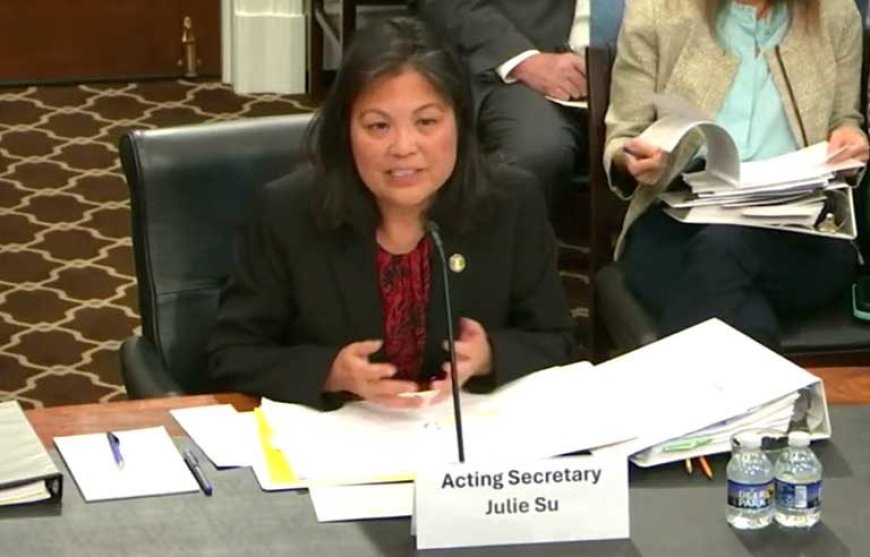DOL seeks funding to investigate child labor violations
DOL seeks funding to investigate child labor violations Safety+Health Magazine

Child Labor Law Protections and the Role of Federal Law
.jpg?height=635&t=1713457966&width=1200)
Washington — As several states move to roll back child labor law protections, acting Labor Secretary Julie Su has a message: Federal law still applies in every state.
“The federal law is a floor,” Su said during an April 17 House Labor, Health and Human Services, Education Subcommittee hearing on the fiscal year 2025 request for the Department of Labor. “We make sure the Department of Labor enforces that floor.”
Emphasis on Sustainable Development Goals (SDGs)
The White House is seeking $7.5 million from Congress to support 50 full-time investigators for child labor violations. In response to questions from Rep. Mark Pocan (D-WI), Su said the department would direct much of its resources to states where DOL is the “last line of defense.”
“We are seeing unconscionable cases of child labor,” Su said to Rep. Rosa DeLauro (D-CT), ranking member of the subcommittee. “We are seeing 13-year-olds working the night shift on the kill floor of meatpacking plants, working with toxic chemicals, doing cleaning. We see young people working as sawmill operators, doing roofing and doing work that is understandably illegal for children.
“We’re not talking about a child who is working at the corner store – learning how to show up on time and provide good customer service and the importance of responsibility and a paycheck. We’re really seeing terrible cases where children are being put in harm’s way.”
Budget Increase for Occupational Safety and Health Administration (OSHA)
Overall, the Biden administration is requesting a little more than $655 million for OSHA – a roughly $23 million increase, or 3.7%. The White House is seeking a 4.8% budget increase, or nearly $19 million more than current funding level (around $387.8 million), for the Mine Safety and Health Administration.
Budget Allocation for National Institute for Occupational Safety and Health (NIOSH)
It’s proposed budget for NIOSH, meanwhile, is unchanged at $363 million.
[embedded content]
SDGs, Targets, and Indicators
| SDGs | Targets | Indicators |
|---|---|---|
| SDG 8: Decent Work and Economic Growth | Target 8.7: Take immediate and effective measures to eradicate forced labor, end modern slavery and human trafficking, and secure the prohibition and elimination of the worst forms of child labor, including recruitment and use of child soldiers, and by 2025 end child labor in all its forms. | Indicator not mentioned in the article. |
| SDG 4: Quality Education | Target 4.4: By 2030, substantially increase the number of youth and adults who have relevant skills, including technical and vocational skills, for employment, decent jobs, and entrepreneurship. | Indicator not mentioned in the article. |
1. Which SDGs are addressed or connected to the issues highlighted in the article?
SDG 8: Decent Work and Economic Growth
The issue of child labor law protections being rolled back is connected to SDG 8, which aims to promote sustained, inclusive, and sustainable economic growth, full and productive employment, and decent work for all. The article highlights cases of child labor in various industries, indicating a violation of decent work standards.
SDG 4: Quality Education
The issue of child labor also relates to SDG 4, which focuses on ensuring inclusive and equitable quality education and promoting lifelong learning opportunities for all. Child labor deprives children of their right to education and hinders their ability to acquire relevant skills for decent employment.
2. What specific targets under those SDGs can be identified based on the article’s content?
Target 8.7: Take immediate and effective measures to eradicate forced labor, end modern slavery and human trafficking, and secure the prohibition and elimination of the worst forms of child labor, including recruitment and use of child soldiers, and by 2025 end child labor in all its forms.
The article highlights cases of child labor in various industries, such as meatpacking plants, sawmills, and roofing. These cases indicate the need to take immediate and effective measures to eliminate the worst forms of child labor and achieve the target of ending all forms of child labor by 2025.
Target 4.4: By 2030, substantially increase the number of youth and adults who have relevant skills, including technical and vocational skills, for employment, decent jobs, and entrepreneurship.
The article mentions that children are being engaged in hazardous work, such as working with toxic chemicals. This highlights the importance of providing relevant skills training and education to youth to ensure they have the necessary qualifications for decent employment and entrepreneurship.
3. Are there any indicators mentioned or implied in the article that can be used to measure progress towards the identified targets?
No specific indicators are mentioned or implied in the article that can be used to measure progress towards the identified targets.
Behold! This splendid article springs forth from the wellspring of knowledge, shaped by a wondrous proprietary AI technology that delved into a vast ocean of data, illuminating the path towards the Sustainable Development Goals. Remember that all rights are reserved by SDG Investors LLC, empowering us to champion progress together.
Source: safetyandhealthmagazine.com

Join us, as fellow seekers of change, on a transformative journey at https://sdgtalks.ai/welcome, where you can become a member and actively contribute to shaping a brighter future.







